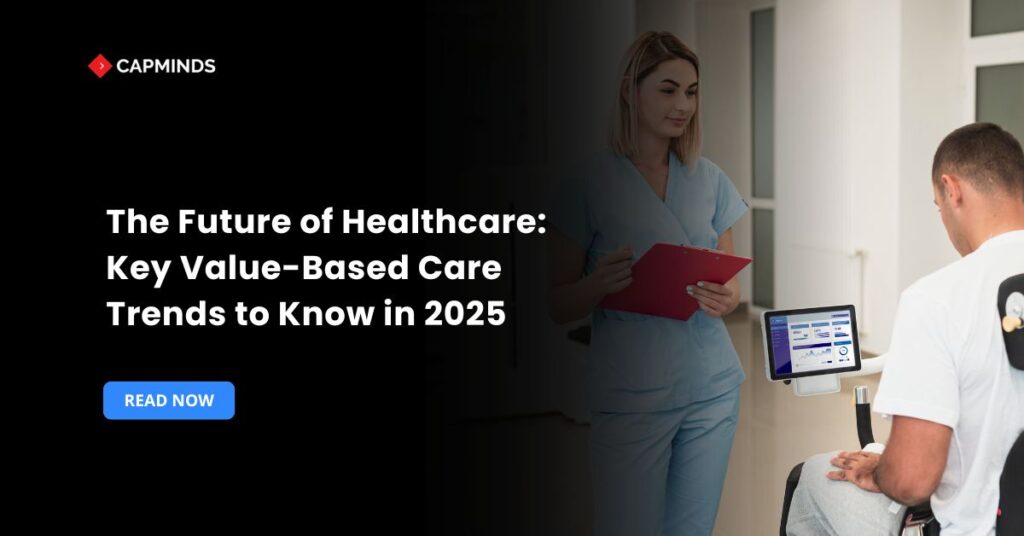The Future of Healthcare: Key Value-Based Care Trends to Know in 2025
The U.S. value-based healthcare market is projected to grow at a compound annual growth rate of 7.41% from 2025 to 2030, reaching $6.16 trillion by 2030.
The healthcare system still faces issues with changing patient outcomes, fragmented service delivery, and growing costs despite massive expenditures in infrastructure.
As a result, patients face rising insurance premiums, unexpected medical expenses, and varying levels of care based on region or insurance type.
By connecting provider compensation to cost-effectiveness, patient outcomes, and quality metrics, value-based care represents an innovative shift. VBC aims to enhance patient satisfaction while reducing overall healthcare costs.
What is Value-Based Care?
A healthcare delivery model known as “value-based care” ties hospital providers’ compensation to patient health outcomes rather than the quantity of services they provide.
Providers assume financial risk for a specific patient group under VBC, and they are compensated if they meet various quality criteria, including cost reductions, readmission rates, preventive screenings, and chronic illness management.
Top Value-Based Care Trends to Know in 2025
1. Growth of Data-Driven Decision Making
- In 2025, real-time data analytics and artificial intelligence will be critical to VBC’s success. Data analytics, according to healthcare professionals, is essential for identifying high-risk patients, enhancing budget allocation, and guiding therapeutic decisions.
- AI-powered risk assessment tools will analyze large clinical and SDoH databases to identify patients at risk for poor outcomes, allowing for targeted treatments before hospitalizations occur.
- Algorithms will identify individuals with poorly managed diabetes in order to provide prompt outreach and care management.
- Integrated software systems will combine quality measures, such as readmission rates and preventive screening compliance, into clinician dashboards, allowing for instant course adjustments.
- Providers can compare their performance to that of peer organizations, therefore promoting continual development.
2. AI and Machine Learning Integration
- Artificial intelligence will transform from an experimental tool to a key component of VBC models. From automating administrative tasks to customizing treatment plans, AI will improve workflows and outcomes.
- Machine-learning algorithms will analyze patient medical histories, lab results, and imaging to make evidence-based treatment recommendations.
- AI can offer appropriate hypertension management methods based on a patient’s characteristics and previous drug responses.
- By 2025, conversational AI chatbots will handle routine queries, appointment scheduling, prescription reminders, and symptom triage, saving an estimated $3.6 billion in worldwide administrative burden.
- These systems will proactively monitor patients after discharge, identifying potential problems before they worsen.
Related: How to Navigate Medicare Billing Changes with a $1M Health IT Investment
3. Telehealth and RPM Integration
- Driven by the COVID-19 pandemic, RPM and telehealth will be further integrated into the VBC strategy. Providers will use connected devices such as glucose monitors and wearable cardiac sensors to monitor crucial health parameters outside of typical settings.
- RPM for chronic illnesses such as congestive heart failure, COPD, and diabetes enables early identification of problems and improves care metrics that avoid costly hospitalizations.
- Telehealth visits will be seamlessly integrated with in-person care pathways to guarantee continuity.
- Integrating telehealth systems will allow multidisciplinary teams, primary care, specialists, and mental health providers to collaborate electronically.
- For example, a patient suffering from depression and chronic pain can consult with both a psychiatrist and a care coordinator in the same virtual session, therefore increasing care coordination.
4. Behavioral Health Integration in Primary Care
- Recognizing the importance of mental health in overall well-being has led more payers to cover behavioral health therapies in primary care settings.
- The number of Medicare Advantage members receiving collaborative treatment from a primary care physician, behavioral health manager, and psychiatric consultant has grown eightfold since the implementation of dedicated billing codes in 2017.
- Urban health systems with supportive leadership and private financing will continue to develop integrated behavioral health teams.
- Proposals in Congress might increase Medicare payouts for collaborative care, making such models feasible in rural or underserved communities.
- Outcome-based care contracts will gradually include behavioral health quality criteria, such as depression remission rates and therapy involvement, connecting a portion of provider compensation to mental health outcomes.
5. Integration of Social Determinants of Health
- VBC models recognize that clinical treatment alone cannot produce optimal results.
- Many healthcare institutions will include SDoH information, such as housing status, food security, and transportation availability, into risk-adjustment algorithms and care pathways.
- An innovative program helps reach out to economically challenged women at risk for breast cancer, demonstrating how meeting socioeconomic needs increases early diagnosis and treatment adherence.
- Providers will develop formal collaborations with social service agencies and community-based organizations to address transportation issues, food insecurity, and housing instability.
- Risk-adjusted data models will quantify the savings from fewer emergency visits, such as MassHealth’s 15% reduction in emergency visits and higher patient satisfaction.
6. Enhanced Patient Engagement and Experience Tools
- Empowering patients with digital tools will be critical to VBC’s success. Digital health tools, such as mobile health applications, customized patient portals, and remote monitoring dashboards, will encourage adherence, self-management, and collaborative decision-making.
- Providers will use data from wearables, smartphone applications, and RPM to generate personalized treatment plans.
- Automated notifications will remind patients when lab tests are due or prescriptions require refilling, raising preventive screening rates.
- Apps that leverage behavioral economics, gamification, goal-setting, and peer comparisons will drive better habits, such as increased physical activity and smoking cessation.
- These features help improve outcomes and reduce long-term costs.
Related: $1M Healthcare IT Budget Planning Guide (With Template)
CapMinds Healthcare IT Consulting
As you plan your 2025 healthcare IT budget, choosing the right technology investments is key to long-term success. CapMinds helps healthcare organizations focus on what truly matters: smarter systems, seamless workflows, and sustainable growth.
Here’s what you should invest in and how we help:
- Custom EHR Solutions – Streamline documentation and align with your clinical goals.
- Interoperability & Integration – Avoid fragmented systems with secure, scalable data exchange.
- Telehealth Platforms – Support hybrid care models and boost patient engagement affordably.
- Healthcare Analytics – Turn your data into actionable insights that guide better decisions.
- Revenue Cycle Optimization – Improve billing accuracy and increase financial returns.
Why CapMinds?
We help you avoid overspending on unnecessary tech and guide your investments toward scalable, compliance-ready solutions.
With our consulting expertise, automation tools, and healthcare IT insight, you’ll be equipped to make budget-friendly choices that drive clinical and operational excellence.
Let CapMinds be your partner in smart healthcare IT planning for 2025. Contact us today to get started.




